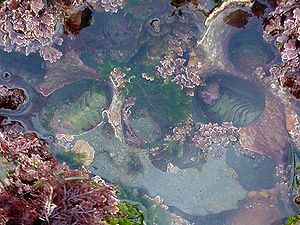

The Mesozoic marine revolution (MMR) refers to the increase in shell-crushing (durophagous) and boring predation in benthic organisms throughout the Mesozoic era (251 Mya to 66 Mya), along with bulldozing and sediment remodelling in marine habitats.[1] The term was first coined by Geerat J. Vermeij,[2] who based his work on that of Steven M. Stanley.[3][4][5] While the MMR was initially restricted to the Cretaceous (145 Mya to 66 Mya), more recent studies have suggested that the beginning of this ecological/evolutionary arms race extends as far back as the Triassic,[6][7][8] with the MMR now being considered to have started in the Anisian[9] or the Aalenian.[10] It is an important transition between the Palaeozoic evolutionary fauna and the Modern evolutionary fauna that occurred throughout the Mesozoic.
The Mesozoic marine revolution was not the first bout of increased predatory pressure; that occurred around the end of the Ordovician.[11] There is some evidence of adaptation to durophagy during the Palaeozoic, particularly in crinoids.[12]
- ^ Erwin, Douglas H. (June 2008). "Macroevolution of ecosystem engineering, niche construction and diversity". Trends in Ecology & Evolution. 23 (6): 304–310. doi:10.1016/j.tree.2008.01.013. PMID 18457902. Retrieved 4 April 2023.
- ^ Cite error: The named reference
Vermeij1977was invoked but never defined (see the help page). - ^ Cite error: The named reference
Stanley2008was invoked but never defined (see the help page). - ^ Cite error: The named reference
stanley1974was invoked but never defined (see the help page). - ^ Cite error: The named reference
Leightonetal2013was invoked but never defined (see the help page). - ^ Tackett, Lydia S.; Tintori, Andrea (1 January 2019). "Low drilling frequency in Norian benthic assemblages from the southern Italian Alps and the role of specialized durophages during the Late Triassic". Palaeogeography, Palaeoclimatology, Palaeoecology. 513: 25–34. doi:10.1016/j.palaeo.2018.06.034.
- ^ Tackett, Lydia S. (1 April 2016). "Late Triassic durophagy and the origin of the Mesozoic Marine Revolution". PALAIOS. 31 (4): 122–124. doi:10.2110/palo.2016.003. S2CID 88004603. Retrieved 9 December 2022.
- ^ Cueille, Marie; Green, Emily; Duffin, Christopher J.; Hildebrandt, Claudia; Benton, Michael James (December 2020). "Fish and crab coprolites from the latest Triassic of the UK: From Buckland to the Mesozoic Marine Revolution". Proceedings of the Geologists' Association. 131 (6): 699–721. doi:10.1016/j.pgeola.2020.07.011. S2CID 226298575. Retrieved 7 January 2023.
- ^ Cite error: The named reference
Salamonetal2012was invoked but never defined (see the help page). - ^ Fantasia, Alicia; Mattioli, Emanuela; Spangenberg, Jorge E.; Adatte, Thierry; Bernárdez, Enrique; Ferreira, Jorge; Thibault, Nicolas; Krencker, François-Nicolas; Bodin, Stéphane (January 2022). "The middle-late Aalenian event: A precursor of the Mesozoic Marine Revolution". Global and Planetary Change. 208: 103705. doi:10.1016/j.gloplacha.2021.103705.
- ^ Cite error: The named reference
Vinn2008was invoked but never defined (see the help page). - ^ Cite error: The named reference
Baumiller2010was invoked but never defined (see the help page).